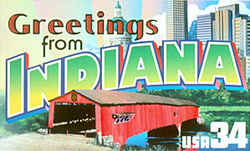Indiana State River
The Wabash River

Adopted in 1996.
The Indiana State River is the Wabash. It was adopted in 1996. The Wabash river is also the theme of Indiana's state song, is mentioned in the state poem, and on Indiana's honorary award (The Sagamore of the Wabash).
The Wabash River Heritage Corridor Commission was authorized with the passage of House Enrolled Act 1382 by the 1991 Indiana General Assembly. The current applicable Indiana Code, IC 14-13-6, was amended by the 1997 and 2005 General Assemblies.
Indiana State River: The Wabash Rive

The Wabash has always been Indiana's most famous river. Occupying the heartland of the state, the river drains two-thirds of the 92 counties as it flows over 475 miles to its confluence with the Ohio below Mount Vernon. The river rises in Ohio near Fort Recovery and flows for only thirty miles before it becomes entirely an Indiana River.
It is a river of many faces and moods. At times it occupies a huge valley which was carved by a glacial runoff but it also flows through a partially
filled valley formed before the glacial advances. In its upper stretches the Wabash moves across the fertile, flat land in a narrow, shallow trench.
The Indians had called it the Wah-Bah Shik-Ki which meant "pure white." When the French arrived they corrupted the word be calling it "Quabache" and
eventually of course, the settlers anglicized the word by spelling it "Wabash." But it was the Indians who first occupied the banks of the Wabash and
many important villages were located along its length. French explorers, missionaries and fur traders were the first white men to arrive on the scene
and the Wabash soon became the great trade route linking the lower Great Lakes and the Mississippi River. Much of the struggle for control of the New
World by the French and British took place along the Wabash and later it was the scene of George Rogers Clark's surprise defeat of the British which
eliminated the British hold on the Northwest Territory. The elimination of the British left the pioneer Hoosiers with only the Indians to contend with.
In 1811, Governor William Henry Harrison and his army defeated Tecumseh at the Battle of Tippecanoe near Lafayette. This victory which should later
launch the campaign slogan "Tippecanoe and Tyler, Too" probably propelled Harrison to the Presidency.
The river was not only the site of war and bloodshed, it was also a center of learning and social advance. This "civilizing" influence was epitomized
by the Rappites, a religious group that formed a communal colony at New Harmony on the lower Wabash. Their experiment lasted 10 years until they sold
their holdings to Robert Owen who initiated another communal colony which was based upon education and science rather than religion. Owen's work at
New Harmony was short-lived but led to the birth of the Geological Survey and the concept of free public schools.
Of course, the Wabash's greatest contribution to the growth of Indiana was its role as a vital transportation link. When the river proved to be too
unreliable, the Wabash-Erie Canal, America's longest, was built along the river. Soon after completion the coming of the locomotive in 1865 resulted
in the doom of the canal. It left a long lasting heritage however, in the diverse ethnic groups who came to work on the canal and then stayed to settle
in the valley. The "canal towns" which developed soon became industrialized and their focus changed from the transportation of goods to the production
of goods.
A little known fact is that during the early 1900's the Wabash and the city of Vincennes in particular was a center of pearling activity. Mussels in
the river were gathered in huge quantities to be used in the manufacture of buttons from the shells. Finding pearls in the mussels set off an unprecedented
rush of activity. Most were imperfect and of little value but occasionally pearls in the $700 to $4000 class were found.
A trip down any other river in the state will not give as complete a view of Indiana as the Wabash. You will not experience a pristine natural environment
(except in isolated sections) but you will see Indiana today and a glimpse of the past. The river is usually muddy and slow moving as it drains much
of Indiana's fertile farmland. This factor alone should not deter you from trying the Wabash. The upper end of the Wabash is very shallow with numerous
log jams clogging the river and making navigation of the river tiring in all but high water (and then it may be dangerous).
Source: Department of Natural Resources
Indiana Law
The law designating Wabash River as the official Indiana state river is found in the Indiana Code, Title 1, Article 2, Chapter 11, Section 1-2-11-1.
TITLE 1. GENERAL PROVISIONS
ARTICLE 2. STATE EMBLEMS
Chapter 11. State River
Indiana Code: IC 1-2-11-1
Sec. 1. The river commonly known as the Wabash River is adopted and designated as the official river of the state of Indiana.
As added by P.L.3-1996, SEC.1.








